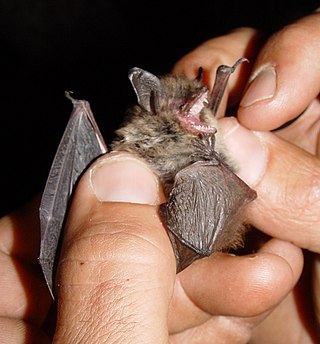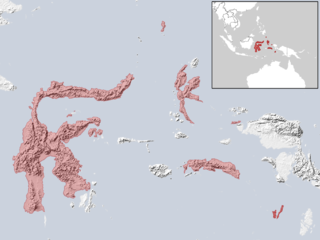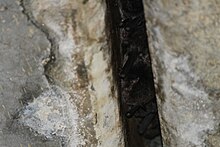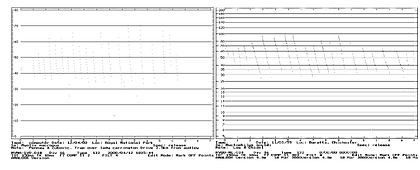
The whiskered bat is a small European bat with long fur. Although uncommon, M. mystacinus is often found around human habitation and around water; it is similar to Brandt's bat, from which it was distinguished as a separate species only in 1970.

The silver-tipped myotis is a species of mouse-eared bat found in a range of lowland habitats in the Americas.

The long-legged bat is a member of the Phyllostomidae family in the order Chiroptera. Both males and females of this species are generally small, with wingspans reaching 80mm with an average weight ranging between 6 and 9 grams. The facial structure of these bats includes a shortened rostrum with a prominent noseleaf. The most defining feature of these bats however, is their long posterior limbs that extend farther than most Phyllostomidae bats. At the ends of these hind legs, the long-legged bat has abnormally large feet equipped with strong claws.

The southeastern myotis is a small bat found throughout the Gulf Coastal Plain and the Lower Mississippi Alluvial Plain of the southeastern United States.

The inland broad-nosed bat is a species of vesper bat. They are endemic to Australia and widespread throughout the inland, especially in arid and semi-arid regions. This insectivorous microbat, measuring 12 centimetres (4.7 in) in length, roosts in tree hollows during the day and forages over woodland and water at night.

Bechstein's bat is a species of vesper bat found in Europe and western Asia, living in extensive areas of woodland.

The Chilean myotis is a species of vesper bat found in southern South America.

The western small-footed bat, also known as the western small-footed myotis, is a species of vesper bat native to North America.

The hairy-legged myotis is a species of mouse-eared bat. It is found from southern Tamaulipas in Mexico, through much of Central America and across northern South America as far east as Trinidad. Further south, it is found along the foothills of the Andes as far south as northern Argentina.

The eastern small-footed bat is a species of vesper bat. It can be found in southern Ontario and Quebec in Canada and in mountainous portions of the eastern United States from New England to northern Georgia, and westward to northern Arkansas. It is among the smallest bats in eastern North America and is known for its small feet and black face-mask. Until recently, all North American small-footed Myotis were considered to be "Myotis leibii". The western population is now considered to be a separate species, Myotis ciliolabrum. The Eastern small-footed bat is rare throughout its range, although the species may be locally abundant where suitable habitat exists. Studies suggest white-nose syndrome has caused declines in their populations. However, most occurrences of this species have only been counted within the past decade or two and are not revisited regularly, making their population status difficult to assess. Additionally, most bat populations in the Eastern U.S. have been monitored using surveys conducted in caves and mines in the winter, but Eastern small-footed bats hibernate in places that make them unlikely to be encountered during these surveys. Perhaps as a result, the numbers of Eastern small-footed bats counted in winter tend to be low and they are relatively variable compared to other species of bats. Many biologists believe the species is stable, having declined little in recent times, but that it is vulnerable due to its relatively restricted geographic range and habitat needs.

Rickett's big-footed bat is a species of vesper bat. It can be found in southern and eastern China, Vietnam, and Laos. This species has often been called Myotis ricketti, but the older M. pilosus has priority. The erroneous reporting of the type locality as being in Uruguay by Wilhelm Peters led to the dual naming.

The fringed myotis is a species of vesper bat that is found in British Columbia, Mexico, and the western United States.

The Yuma myotis is a species of vesper bat native to western North America.

The Alcathoe bat is a European bat in the genus Myotis. Known only from Greece and Hungary when it was first described in 2001, its known distribution has since expanded as far as Portugal, England, Sweden, and Russia. It is similar to the whiskered bat and other species and is difficult to distinguish from them. However, its brown fur is distinctive and it is clearly different in characters of its karyotype and DNA sequences. It is most closely related to Myotis hyrcanicus from Iran, but otherwise has no close relatives.

Myotis septentrionalis, known as the northern long-eared bat or northern myotis, is a species of bat native to North America. There are no recognized subspecies. The northern long-eared bat is about 3–3.7 inches in length, with a wingspan of 9–10 inches. It is distinguishable by its long ears when comparing it to other bats in its genus. This species is commonly found in the northern United States and Southern Canada east of British Columbia. The geographic range includes 37 states.

The California myotis is a species of vesper bat. It is found in British Columbia in Canada, Guatemala, Mexico, and in the western United States, including California.

Daubenton's bat or Daubenton's myotis is a Eurasian bat with rather short ears. It ranges from Ireland to Japan (Hokkaido) and is considered to be increasing its numbers in many areas.

The elegant myotis is a species of vesper bat found in Belize, Costa Rica, El Salvador, Guatemala, Honduras, Mexico, and Nicaragua.

The Dharawal National Park is a protected national park that is located in the Illawarra region of New South Wales, in eastern Australia. The 6,508-hectare (16,080-acre) national park is situated between the Illawarra Range and the Georges River and is approximately 45 kilometres (28 mi) south west of Sydney. There are three entry points to the park: from the east through Darkes Forest; from the north through Wedderburn; and from the south through Appin.

The Maluku myotis, also commonly known as the Arafura large-footed bat, is a species of mouse-eared bat. Native to Indonesia, and possibly New Guinea and northern Australia, it one of several species known as "fishing bats" because they catch their prey on the surface of water, scooping it up with their large feet.






















